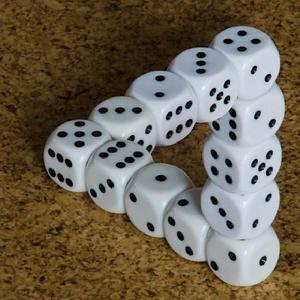Python之排列组合
 #1,排列
#1,排列
比如随机抛两个或三个骰子,列出所有的可能:
import itertools
a = range(7)[1:]
print list(itertools.product(a)) #一个骰子
print list(itertools.product(a, a)) # 两个骰子
>>> print list(itertools.product(a, a))
[(1, 1), (1, 2), (1, 3), (1, 4), (1, 5), (1, 6), (2, 1), (2, 2), (2, 3), (2, 4), (2, 5), (2, 6), (3, 1), (3, 2), (3, 3), (3, 4), (3, 5), (3, 6), (4, 1), (4, 2), (4, 3), (4, 4), (4, 5), (4, 6), (5, 1), (5, 2), (5, 3), (5, 4), (5, 5), (5, 6), (6, 1), (6, 2), (6, 3), (6, 4), (6, 5), (6, 6)]
#**2,组合 **
比如随机抛10个女孩中挑3个约会,多少种情况
import itertools
a = range(11)[1:] #没必要是数字~
print itertools.combinations(a, 3)
print len(itertools.combinations(a, 3))
>>> print list(itertools.combinations(a, 3))
[(1, 2, 3), (1, 2, 4), (1, 2, 5), (1, 2, 6), (1, 3, 4), (1, 3, 5), (1, 3, 6), (1, 4, 5), (1, 4, 6), (1, 5, 6), (2, 3, 4), (2, 3, 5), (2, 3, 6), (2, 4, 5), (2, 4, 6), (2, 5, 6), (3, 4, 5), (3, 4, 6), (3, 5, 6), (4, 5, 6)]
>>>
#3,有序的抽样
上面那种情况是无序的组合,比如10个女孩挑3个,安排好顺序约会,那就得 10!/(10 - 3)!
import itertools
a = range(11)[1:]
print list(itertools.permutations(a, 3))
>>> print list(itertools.permutations(a, 3))
[(1, 2, 3), (1, 2, 4), (1, 2, 5), (1, 2, 6), (1, 3, 2), (1, 3, 4), (1, 3, 5), (1, 3, 6), (1, 4, 2), (1, 4, 3), (1, 4, 5), (1, 4, 6), (1, 5, 2), (1, 5, 3), (1, 5, 4), (1, 5, 6), (1, 6, 2), (1, 6, 3), (1, 6, 4), (1, 6, 5), (2, 1, 3), (2, 1, 4), (2, 1, 5), (2, 1, 6), (2, 3, 1), (2, 3, 4), (2, 3, 5), (2, 3, 6), (2, 4, 1), (2, 4, 3), (2, 4, 5), (2, 4, 6), (2, 5, 1), (2, 5, 3), (2, 5, 4), (2, 5, 6), (2, 6, 1), (2, 6, 3), (2, 6, 4), (2, 6, 5), (3, 1, 2), (3, 1, 4), (3, 1, 5), (3, 1, 6), (3, 2, 1), (3, 2, 4), (3, 2, 5), (3, 2, 6), (3, 4, 1), (3, 4, 2), (3, 4, 5), (3, 4, 6), (3, 5, 1), (3, 5, 2), (3, 5, 4), (3, 5, 6), (3, 6, 1), (3, 6, 2), (3, 6, 4), (3, 6, 5), (4, 1, 2), (4, 1, 3), (4, 1, 5), (4, 1, 6), (4, 2, 1), (4, 2, 3), (4, 2, 5), (4, 2, 6), (4, 3, 1), (4, 3, 2), (4, 3, 5), (4, 3, 6), (4, 5, 1), (4, 5, 2), (4, 5, 3), (4, 5, 6), (4, 6, 1), (4, 6, 2), (4, 6, 3), (4, 6, 5), (5, 1, 2), (5, 1, 3), (5, 1, 4), (5, 1, 6), (5, 2, 1), (5, 2, 3), (5, 2, 4), (5, 2, 6), (5, 3, 1), (5, 3, 2), (5, 3, 4), (5, 3, 6), (5, 4, 1), (5, 4, 2), (5, 4, 3), (5, 4, 6), (5, 6, 1), (5, 6, 2), (5, 6, 3), (5, 6, 4), (6, 1, 2), (6, 1, 3), (6, 1, 4), (6, 1, 5), (6, 2, 1), (6, 2, 3), (6, 2, 4), (6, 2, 5), (6, 3, 1), (6, 3, 2), (6, 3, 4), (6, 3, 5), (6, 4, 1), (6, 4, 2), (6, 4, 3), (6, 4, 5), (6, 5, 1), (6, 5, 2), (6, 5, 3), (6, 5, 4)]
综上所述:
排列—itertools.product()
组合—itertools.combinations()
阶乘—factorial(num)
blog comments powered by Disqus